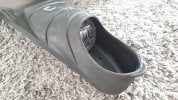When searching for footpocket stretching / molding, I've never found a step by step for CETMA's S-Wing footpocket or any general procedure that didnt involve a heatgun, hairdryer or sliding the foot with layers of socks inside the 100C/ 212F heated footpocket so I hope this approach* will help solving the foot pain/ discomfort for some of you.
Context: CETMA's sky-boot design has several high stiffness bands that will keep your foot tightly fitted and will avoid energy dissipation due to rubber deformation. This is great but it becomes painful after 20 minutes on the "intermediate cuneiform bone" - this is the inner part of the foot where it is arched the highest.

I wish CETMA could mold a left and right footpocket considering this relevant anatomical detail. Until this day comes, follow the steps that worked for me.
Step by step (Disclaimer: do it at your own risk )
)
1. Find a heat resistant object to stretch the area that you want. This candle glass had the right measurements and worked perfectly.

2. Place it inside the footpocket and secure it in place to avoid dislodging the candle glass while the footpocket is in the pot with boiled water


3. Boil the water, turn off the fire, and place your footpocket inside the pot.
3.a. Timing is a case by case basis so check and adapt. In my case, the first footpocket I've done two rounds of 5 minutes and the second footpocket, one round of 10 minutes with the same outcome
3.b. If required, tilt the footpocket inside the pan depending on the area you want to have it molded/ stretched.
3.c. NB: Virgin olive oil is used for illustration purposes only

4. Remove it from the pot and let it cool (with the candle glass still inside the footpocket) for 20 minutes.
5. That's the before and after - with the bulged section

*6. Additional thoughts and notes:
6.a. This approach may be better suited for thermoplastic rubber which is the case of CETMA's S-Wing. If the footpocket material is 100% rubber, it may not hold the stretched section after it cools off.
7. Enjoy a pain/discomfort-free training session!
Context: CETMA's sky-boot design has several high stiffness bands that will keep your foot tightly fitted and will avoid energy dissipation due to rubber deformation. This is great but it becomes painful after 20 minutes on the "intermediate cuneiform bone" - this is the inner part of the foot where it is arched the highest.
I wish CETMA could mold a left and right footpocket considering this relevant anatomical detail. Until this day comes, follow the steps that worked for me.
Step by step (Disclaimer: do it at your own risk
1. Find a heat resistant object to stretch the area that you want. This candle glass had the right measurements and worked perfectly.
2. Place it inside the footpocket and secure it in place to avoid dislodging the candle glass while the footpocket is in the pot with boiled water
3. Boil the water, turn off the fire, and place your footpocket inside the pot.
3.a. Timing is a case by case basis so check and adapt. In my case, the first footpocket I've done two rounds of 5 minutes and the second footpocket, one round of 10 minutes with the same outcome
3.b. If required, tilt the footpocket inside the pan depending on the area you want to have it molded/ stretched.
3.c. NB: Virgin olive oil is used for illustration purposes only
4. Remove it from the pot and let it cool (with the candle glass still inside the footpocket) for 20 minutes.
5. That's the before and after - with the bulged section
*6. Additional thoughts and notes:
6.a. This approach may be better suited for thermoplastic rubber which is the case of CETMA's S-Wing. If the footpocket material is 100% rubber, it may not hold the stretched section after it cools off.
7. Enjoy a pain/discomfort-free training session!
Attachments
Last edited:



